You’ve got teens and tweens now. You’ve evolved from the monkey backpacks that had leashes to them tripping over their own ever-growing feet. They want to create their own island within the house that allows them to marinate in Youtube sans interruption. You want to have shared family adventures in the great outdoors sans technology. Whether you want to engage your kiddos in a family bonding outdoor experience, empower your children to be safe and knowledgeable about hiking, or want them to help plan for your next national park adventure, this is your guide to teaching your kids about hiking preparation and safety. Hiking is an activity that is about more than tips and trails. This is an opportunity to get away from it all, bond outdoors, and teach life skills in the process.
Table of Contents
Types of Hikes
The first thing to consider is the type of hike. Be clear with your kids what the difference is between types of hikes. They in turn can be prepared as opportunities come across their paths. There is a big difference between your older teen getting invited to go backpacking with friends over a long weekend vs. taking an extended break from college to do thru hiking of the Pacific Crest Scenic Trail. Teaching them the difference empowers them to make safe choices.
Day Hiking – getting out into nature and unplugging temporarily from the day to day hustle of life. Evenings are spent in the relative luxury of the indoors.
Backpacking – multiple days of hiking and overnight stays outdoors. This can be a weekend or a weeklong outdoor adventure. It includes a bit more preparation for packing, a small number of overnights and meal planning
Thru Hiking – this is a long, high mileage trail that is a species of outdoor adventure all its own. There is a certain mental preparation and commitment to Thru Hiking. It requires the hiker to educate him or herself on long term planning and preparation.
Day hiking is our focus for this article but the tips here could easily apply to a short weekend backpacking trip. For those of you interested in Thru Hiking … God love you.
Get Your Travel Goals Newsletter & BONUS Workbook
Researching Trails
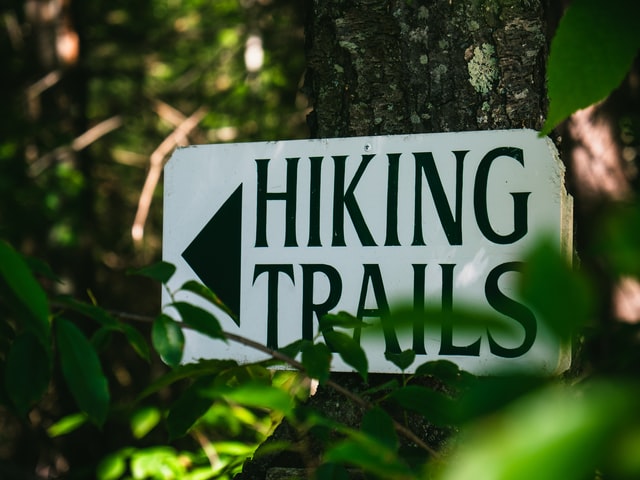
Show your teens how to use All Trails, blogs, or park websites to educate themselves about which trails are best for your family. You don’t necessarily have to teach them how to read a topography map (go for it if you have the patience). But they should develop an understanding of trail ratings on the site of their choice as well as elevation gain. The formula used to determine difficulty could be different for each site you visit. It usually involves some type of math with distance and elevation gain. As a family you can create guidelines for beginners (e.g., 2 – 3 miles round trip distance and up to 300 ft. elevation gain) and/or moderately skilled day hikers (e.g., 4 – 8 miles round trip distance and up to 900 ft. elevation gain) depending on your family’s health and who is going along for the trip.
Research seasonal constraints for the area. Is the trail only open on the weekends during the winter months? Are roads closed when it snows? What are the expected temperature levels in the summer? Show your teen how to research not only for general season considerations but also, as the event gets closer, to check out weather expectations for the day/week.
Considering multiple trails? How much time do you have? Think about your pacing and how long it takes you to walk a mile right now. The more strenuous the trail the less mileage you’ll get per hour hiking. Look to see if the park or trail website can give you an expected time estimate. Then add to it based on expected breaks. For example, we hiked a rather strenuous trail at Pinnacles National Park that listed 3 hours expected, but we took 4 to complete it (I’d like to say it was because we stopped to take a lot of pictures, but let’s face it we stopped because we were sucking wind. Photography is a total cover-up – I’m outing all of you).
Get Your Travel Goals Newsletter & BONUS Workbook
Teach your teen to consider how you’ll navigate the trail. Is this a point-to-point easy trail that’s less than a mile? Are you ok with someone missing it to drop you off and park at the far lot? Or do you want to stay together and make it a round trip of almost two miles? Are the parking lots usually full by 9 AM? Is there a second lot available nearby? Get them thinking about the whole process so they don’t end up missing out due to a lack of planning.
How to Train for a Hike
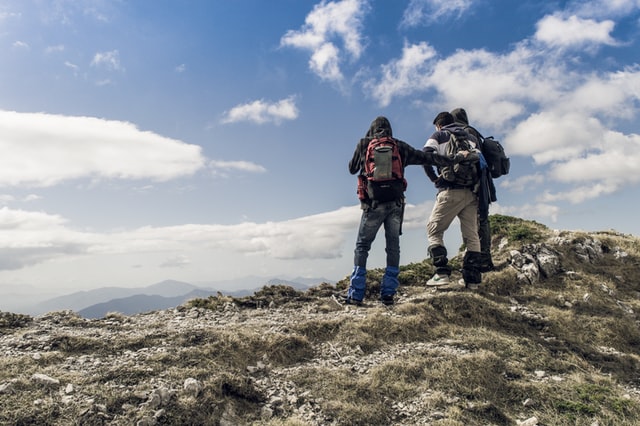
A hiking trip will be much safer if you are ready for the physical demands of your adventure. Talk with your family honestly about your current levels of fitness. What kind of walking and/or running are they willing to do in order to prep for a future hiking trip? Walking the level sidewalks of suburbia will be much more straightforward than a hike with drop-offs and 1,000+ feet elevation gain. So remind your teen to consider what type of walking or where you are running when getting ready for a hike. Or you can always suggest practicing on easier trails first.
Strength training can also be a part of hike preparation. We don’t just use our legs to walk a trail. Carrying a day pack uses core muscles. All that drinking water gets heavy! A pack can strain shoulders and neck muscles if this is a new activity.
Speaking of strained muscles, let’s not forget the power of stretching. Introducing simple yoga moves and stretches can help prevent injury. Teach teens to stretch and warm up their muscles before stepping out on the trails.
What to Pack
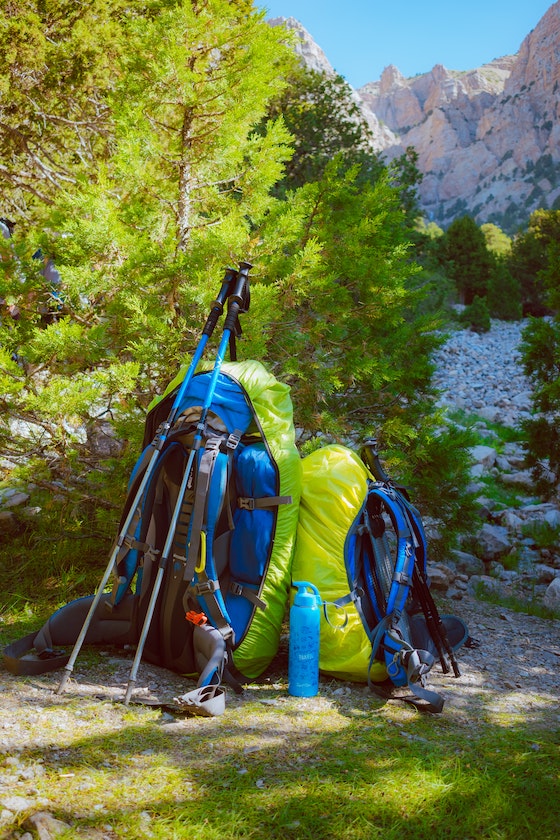
Teens and tweens can definitely pack their own backpacks and suitcase for that matter. This is an empowering activity and allows them to make choices and deal with those choices. I’m not embarrassed to say that we let one of our kiddos hug himself and shiver through most of a day in Yosemite in late fall because he was going through a “shorts only” phase and wouldn’t wear anything else. Hiking pants just were not in his repertoire at the time regardless of parental warnings. So there you go – an instant learning experience for him. Now I’m not suggesting you hike to Everest Base Camp with a kid who will only wear shorts but … Owning packing responsibilities comes with age and just requires a bit of training. Providing them with an essential gear list is a huge help. Follow this list and your teen will be ready for most outdoor adventures.
Backpack – A high-quality, lightweight day pack or backpack is vital to a successful hike. Having one that fits right and can sit comfortably on your back when fully packed is worth the investment.
Water and snacks – water and high-protein snacks that can keep you hydrated and energized throughout the day.
Sun Protection – you don’t want burned skin so grab a hat and sunscreen.
Extra layers – warmth may not be on your mind in the middle of a sunny day. But when the sun goes down you’ll be grateful for those extra layers of warmth. Hiking clothing, appropriate to the day’s overall weather, can be complemented with a fleece or wool pullover, rain jacket or gloves to make you more comfortable.
Illumination – planning on a sunrise or sunset hike? You’ll want to have a headlamp packed in your gear. They are relatively small and can save you from long dangerous walks in the dark.
Navigation – make sure you’ve got a designated map carrier in the group. Another option is to download the trail maps to your phone so you don’t need service to read them. The All Trails Pro version or Google Maps provides this option.
First Aid Kit – there are small kits that fit in the bottom of a pack. You’ll be glad to have it if the situation arises.
Emergency Kit – going on a more remote hike for a long distance? A small collection of life-saving items can fit into a small bag and complement your first aid kit. If need them you’ll be glad to have waterproof matches, a whistle, a knife, and a compass. You can create emergency shelters from a space blanket or simply a large plastic trash bag. These are small on space but huge on comfort if an emergency arises.
Sanitary Items – when you gotta go, you gotta go. And if your tribe is out in the wilderness there is a way to be prepared for such a situation. Bring a trowel and biodegradable wipes to help take care of business.
What to Wear
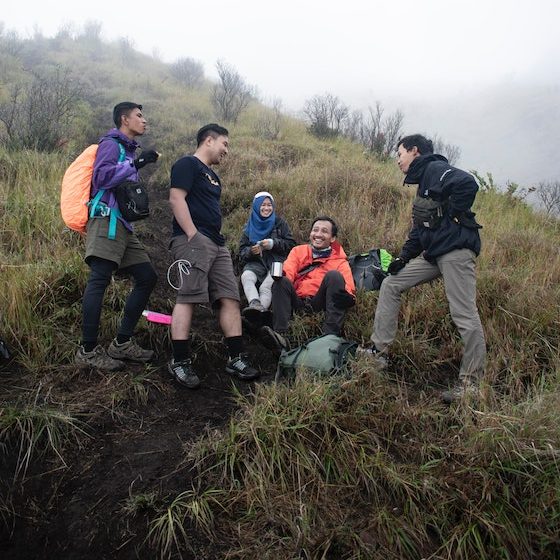
There are some basic clothing specifics that need to be taken into consideration based on the location of your hike. Is this a short hike in sunny California in the late spring? Or are we hiking uphill in the snow at one of the Utah Big 5 national parks in mid-November? Teaching your kiddos about the best clothing to wear while hiking can make the experience more positive, make them feel less vulnerable to the elements, and bring them back to the outdoors again and again. Consider introducing this basic hiking clothing list to your teen to help them pack with intention.
Dress in layers – it may be cold in the mornings and evenings. But once the sun is out and you’re active that layer can come off. You’ll want to have a moisture-wicking shirt and warm fleece layers you can remove.
Rain jacket – this is light and easy to pack as it doesn’t take up much room. You’ll be grateful to have it if it’s needed.
Hiking boots – for safety and comfort make sure you have proper hiking boots with good tread. Ankle support is essential. More challenging moderate/strenuous trails are not the place to realize your running shoes just won’t cut it.
Thick socks – your socks are all that stand between you and a blister. Make sure you have thick, sturdy socks. They should stand up to miles of walking and not slip down to the arch of your foot mid-trail.
Hat and sunscreen – cover up from the sun to avoid sunburn, especially if it is warm and your teen wants to wear a tank top. Nothing rubs worse than a pack strap on sunburned skin.
Day pack or backpack – each kiddo can carry their own pack at this point in life so one parent doesn’t have to feel constantly like the mule.
Camera and camera clip – this is optional. But remember how I suggested photography stops can help in more ways than one.
Get Your Travel Goals Newsletter & BONUS Workbook
Hiking Safety
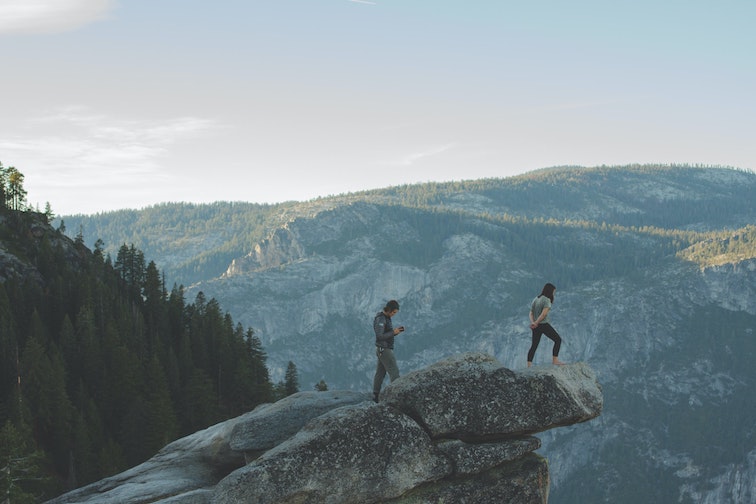
Yeah, there are some basic safety issues that this picture brings to mind. No child, you shouldn’t walk towards the cliff with face in phone. Hope your feet aren’t sweaty my dear, as you lean over the precipice while barefoot. Oh, and while we’re talking let’s agree to not walk backwards to get that perfect selfie of hiking Angel’s Landing at Zion. Dear Lord, I’m elevating my blood pressure just thinking about it. But hey, deep breath, chill out…not my monkeys, not my circus.
As a parent in order to stay sane, you focus on what is in the realm of your sometimes questionable influence. You and your tribe will be all the better for following these basic safety tips.
Itinerary – teach your kiddos to leave an itinerary in the center console of your car at the trailhead. Always let someone know when you are heading out, especially if going solo.
First Aid Kit – all hikers should have this on hand even if only planning for a hike that last a couple of hours.
Trail Map – teens can learn to keep a map of the trail on hand that doesn’t require cell phone service. If a trail is not well-marked hikers are happy to have a map to help negotiate the surrounding areas.
Wildlife Safety
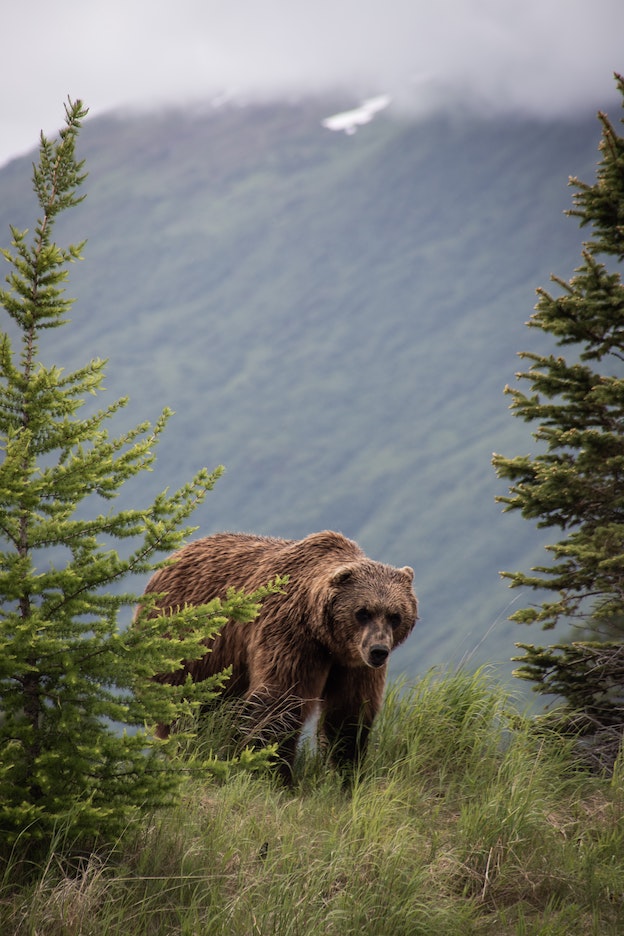
Teaching our children to not only love being out in nature, but also to respect it and honor boundaries is a vital part of educating them for a positive outdoor experience.
National and state park websites will remind us to not scream or shout while on park trails and this is a good thing. But there is a level of natural noise that we make hiking along a trail and that’s ok. Don’t try to be silent while hiking. Natural levels of noise warns animals in advance that humans are coming and they often will leave the immediate environment. If it seems that an animal is getting too close, stand still and make a calm but louder noise to announce yourself, slowly raising your arms out wide. This lets it know you are human, not prey or competition.
With that being said, your goal is to teach your kiddos to keep their distance from wildlife. Animals in the wild are best admired from a far distance. Always stay calm. If an animal gets too close, sudden noises and quick movements are not recommended. Back away if necessary always keeping your eye on the animal to see what its reaction is going to be. The National Park system has this webpage to help you discern the best course of action for dealing with bears specifically.
Don’t forget what is cute and cuddly looking from a distance has its own priorities up close.
Get Your Travel Goals Newsletter & BONUS Workbook
Hiking Trail Etiquette
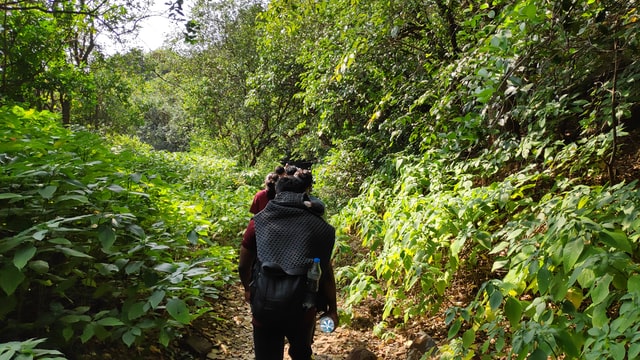
You want to teach your teens and tweens about the right of way. Besides simple rules like don’t play music and step aside to let others pass when you are stopped, there are a few codes of conduct that help kids know how to negotiate situations that may happen on crowded trails. Pay attention to your surroundings if you have to step off trail to let others pass as native flowers or plants can be damaged.
Hiker vs. Hiker – the group hiking uphill has the right of way but always step to the side to let others pass if you are stopped to rest.
Hiker vs. Biker – bicyclists should give the right of way to hikers or horses. Come to a full stop, especially if negotiating the path with horses, and let others pass.
Hiker vs. Horse – hikers should always yield to horses. If coming up from behind calmly announce yourself and your intention to pass. Step as much to the side as possible while approaching.
Our boys did a brief stint in the Boy Scouts and they left with a strong sense of the Leave No Trace principles. This short list of seven points allows us to make the smallest impact on the environment as possible. This is an important thing to teach our kiddos so that the environments we hike in can be around for generations to come.
Living on the East Coast and interested in supporting a fantastic organization to get all kids out into nature? Check out the outdoors.org Youth Program.
Ready to get your tribe out into the great outdoors? Check out our post on One Perfect Day in Zion National Park. Or try a California adventure that avoids the crowds by hiking Pinnacles National Park.
Hiking with your tribe can encourage an active lifestyle for the years to come. Just follow the steps in this article to have a more enjoyable experience with your tweens and teens. And let us know in the comments how your hike went! Do you have any advice you’d like to share with families who are venturing out this year? Share it with us so we can all benefit!
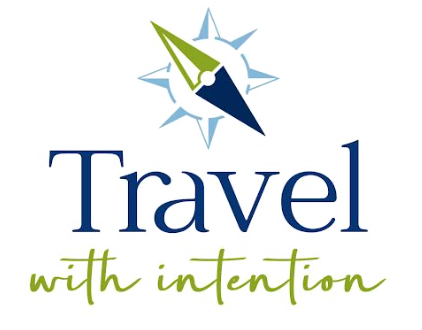
I love that your boys learned leave no trace principles in Scouting. Our Troop is very strict about that with our Scouts so we are always welcome anywhere because they know we will leave the campground cleaner than before.
Yes! So important! Thanks for adding your thoughts to the post.